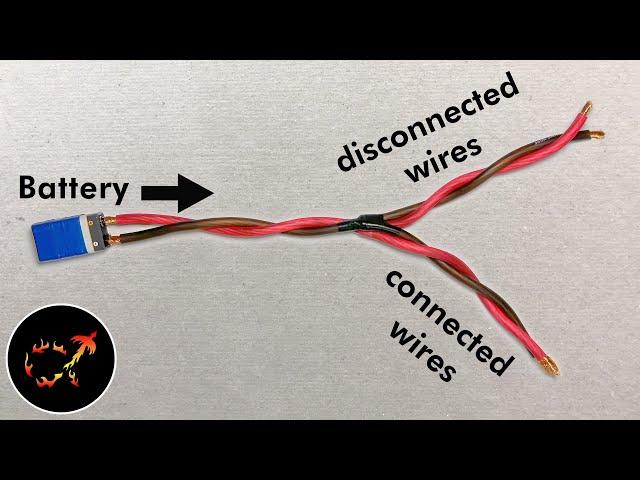
Watch electricity hit a fork in the road at half a billion frames per second
Комментарии:

My guess is C: The electrons will be dumped into both branches until such a time as the buildup of electrons in the disconnected branch repel any extra ones,
Ответить
never thought I'd hear "scooch" to describe something technically 😂
Ответить
One more thing at the end of the video you are surprised that the water model works so well. But why is this surprising? both water and the EM-Field are traveling in waves. it's actually the EXACT SAME phenomena. I'm confused why you are confused.
Ответить
> if that were the case this zigzag layout wouldn't work, because the electric field would cover the setup at the speed of light
But you literally measured the electric field at different points in the wire, that's what voltage is and it's SO MUCH COOLER than what you give yourself credit for. You literally recorded the electric field slosh through a wire.
The field potential V in the wire is approximately zero and outside it's approximately infinity. The wave in the electric field propagates along this valley of zero-potential. God I love this video.

My guess is option c
Ответить
this is amazing. this is the single best video explaining how electrons move in electric circuits.
Ответить
What an awesome video, thank you and well done! One of ye olde name for "Voltage" would have been great to drop into this video (or a followup) - "pressure" ... it's so very relevant when you're describing the electrons bunching up and spreading apart.
Ответить
In my head, it is the bunching up that is one side of Voltage; the distance between electrons causes a repelling force to each other, and when a wire of less electron pressure is presented, they try equalizing the pressure into it, causing a pressure wave.
Also, If the EM wave were to be affecting all the wires as a passing wave, it would indeed not show that big of a difference in propagation time, but I think it would also need to divide the initial energy of the source into all the wires in paralell, causing a drastic decrease in current in each individual wire VS the single wire source current.

To me the electrons or the space between seams to be elastic. Or there wouldn’t be any delay
Ответить
This is the way electricity should be explained in schools
Ответить
Just like all the other comments - two degrees in physics and engineering and this is the best visualisation of electrodynamics I’ve ever seen — even compared to all the simulations I’ve seen done and I wish you were around when i was trying to learn this
Ответить
Who said everything is a spring? Because everything is a spring. Maybe we should compressed air instead of water, due to the compressability.
Ответить
So is the second wire really necessary ? If You remove it, then everything will still behave like an open circuit but with a larger gap. Can You remove one wire ? But then will You be able to measure the wake traveling through one wire somehow ?
Ответить
This is incredibly impressive, imagine how useful it would be to have this in physics classrooms!
Ответить
I have been unable to explain this intuition to so many people thank you for making this diagram this is amazing
Ответить
Is the second wire in the twisted pair required? would we see a similar effect only with one wire? (similar to the open circuit pair)
Ответить
Thanks a million for this wonderful visualization. I can only imagine how much effort went into this. 👏👏👏
Ответить
why keep talking about battery "asking", "knowing", "communicating", it does none of this, it simply is a source of potential that obeys the rules of the circuit you put in place, there is nothing magical or organic about it
good visualization though, but this "dumb" way of presenting makes it unwatchable for me

Interesting demonstration. This, of course, is a transmission line problem, not an AC or DC circuit problem. Brings back fond memories of my "T-Waves" class in college. Certainly not intuitive at first glance but once you understand the fundamentals it's straightforward.
Ответить
If you think of the open panel as a capacitor, it's pretty easy to pick C as the only viable option from those four. But getting the entire picture of reflections that get you to steady state is another thing entirely! Beautiful.
Ответить
Wow, I was shocked to see how similar the water demonstration was to the bar graph.
Stupid question, does the ocsilloscope not complete the circuit on the disconnected side? Of course you would read voltage when you hook up a meter, but what about when there is nothing to connect the wires?
Am I thinking about this wrong? This was an impressive video so I hope I am wrong.
edit:typo

I think one of the reasons that the water example doesn’t exactly match the electricity example is that the relationship of water molecules to the bucket of water is not scaled appropriately to the relationship of electrons in a non-volt battery. If you were to hook your water analog up to a pond or a lake I think you would see a a closer match the two systems. I know you accomplish some of this by increasing the resistance in the electrical wire, but I do think that the relationship to source and traveling down the wire/channel scale is so dramatically different that much more water is needed at the end/reservoir to properly approximate the electrical circuit. All that said amazing video. I appreciate it. Good work.
Ответить
I believe its option c
Ответить
one thing that's weird is how you say the "correct" number of electrons that should flow according to ohms law.... Ohms law is defined for DC, but when you flick the switch the circuit is not DC it's changing. the current that flows after you flip the switch is determined by the IMPEDANCE of the cable connected to the switch, basically the solder joint, a bit gets reflected depending on the impedance of the cable and the solder joint, then when it meets the next impedance change (in the y-intersection) again some part gets reflected and current flows depending of the impedance. At the end of both forks one side is high impedance (open circuit), so all of the wave gets reflected and the low impedance side drops in voltage. High voltage drop = high current flow since the impedance doesn't change (much).
You can also explain all of this using Maxwells Equations.

I cannot overstate how grateful I am for you making this video. Your approach to demystify things rather than presenting them as some magical ways the nature works is something all science communicators should strive for.
Granted, the amount of work that has been put into this video far exceeds what would have been enough for a "you won't believe how electricity really works" type production. However, this only proves that to really give a satisfactory explanation, you have to perform the actual experiment first and then use technology to visualize results, rather than use cool computer graphics to explain what you merely believe is happening.

“*that we’ll talk about in the next video”
Lmao subbed

How to do node voltage analysis without math and animated it. You gonna have to fight Thévenin, Millman and the rest when you go to heaven.
Ответить
I am a curious person with little formal education and this EXACT question has been bouncing around my head for years. You sir are amazing for answering it in such a visual way. Love the testing. Subbed
Ответить
You were so close to explaining antennas :) Next video maybe ?
Ответить
The confusion from this stems from the fact that schools only teach physics at an equilibrium state and brush over the behaviour at an impulse. The irony of oversimplification is that you can only get an intuitive understanding of a capacitor and other models after you understand how impulse changes in fields work because they’re intrinsically connected
Ответить
I didn’t post it before but I was right with my guess
Just thought you should know

Publish in nature !!
Ответить
I don't think people realize exactly HOW much WORK you had to put in to come to the result being depicted in this video.
Like, the amount of testing and changing... building those frames, twisting the wires, splicing, connecting the probes, getting the data, repeating it again and again to get many datasets, trying out different ways to animate the data, comparing the animations to determine which animation looks best, comparing the datasets to determine which dataset looks best when animated, recording all of the footage, editing the footage, building the liquid model, etc etc etc.
I could go on and on!
I'd imagine this whole thing took a good part of a month.
Like.... if you were to do only work on this project 24x7, it would've taken nearly 3 weeks of working 24x7 without eating or sleeping or doing anything else!
Hats off man, hats off.

Impressive. Excellent experience and comparison. Thank you
Ответить
nanoseconds = billionths of a second = gigaherts - 5 ghz cpu - 1/5th of a nanosecond is the amount of the time that a cpu has to propagate new values to the beginning of transistors, cascade through the bus, and assign a value to the output for the next clock cycle to use .... modern CPU's are so far from traditional digital logic that we conceptualise them at that it is funny (yes, we're dealing with mm distances not actual m, but what is going on is more than 1000x the electrical complexity as this straight wire as you've got transistor switching cascades ...
Ответить
Anyone who has been zinged by a relay coil when power is disconnected, knows what the correct answer is.
Ответить
Um... without having watched the video, all four options seem wrong at face value. All four assume that the battery-wire system is a unit and power would only flow once the system is fully mapped. That doesn't really track for me. edit You keep anthropomorphising your electrical components. The battery "knows", the wires "decide", there's an exchange of "information". What is this based on? Because the stats you got and the graphic you showed look pretty much like wave propagation through a channel.
Ответить
This is an amazing, comprehensive and educational video. Much appreciated.
Ответить
This is by far one of the coolest measured explanations of electricity i've ever seen! I've intuitively understood it before, but your demonstration validated my understanding! Thanks for an amazing video!
Ответить
Have you tried power it from AC ?
Ответить
brother, i'm just trying to finish my little m7 with some some dram layout and you're giving me anxiety 😮💨
Ответить
as with the previous water channel video this is just, really cool and intuitive to see play out. it's fascinating how you can see the voltage in the graphs sloshing around in a way that's so analogous to how you'd expect water to behave. i think a lot of science education and communication tends to make out the fundamentals of electricity to be a lot more complicated and unintuitive than they need to be, and i don't think it's ill-intentioned. but it has led to misconceptions like the idea that electrons Don't Move At All in electric currents when the reality is electricity is all about electrons moving and pushing on each other. so being able to take the actual data and visualize it in a way maps pretty neatly onto macroscopic, everyday phenomena really helps dispel a lot of that cloud of ineffable mystery around electricity
Ответить
My guess is C, although Veritasium's old video would suggest it's B.
Ответить
It's never been a better time to learn.
Ответить
Looking at the animation it seems it behaves just like a fluid filling an empty container, much like your water demonstration..
Ответить







![Menurut Kaela dan Risu kalau HoloID member diajak main game Horror [HoloClip Sub ID || Kaela, Risu] Menurut Kaela dan Risu kalau HoloID member diajak main game Horror [HoloClip Sub ID || Kaela, Risu]](https://ruvideo.cc/img/upload/d0NFWU1FcHpDLUY.jpg)

















